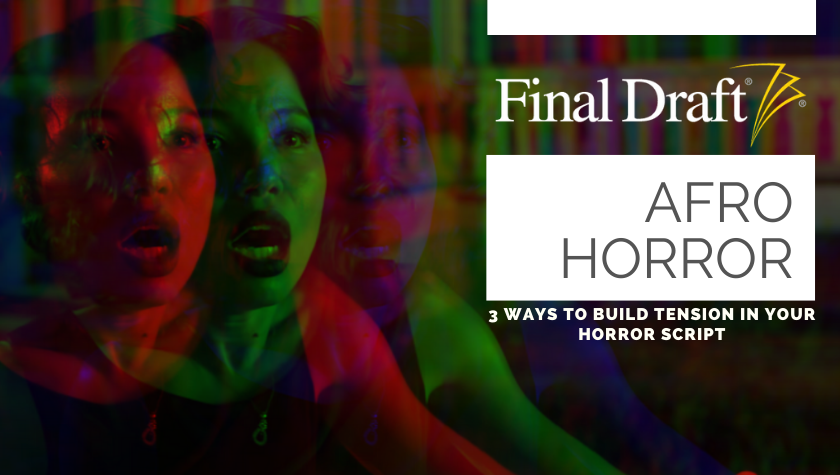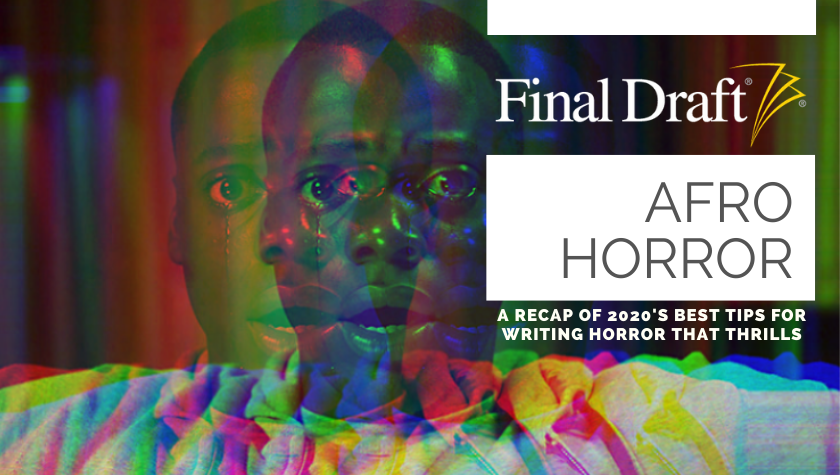Afro Horror: 3 Tips on Writing a Balanced "Final Girl"
October 30, 2020
What makes the ultimate final girl? As you sit down to outline your horror, you may be asking yourself this same question and the answer is actually really simple. But before we deep dive into the makings of the next Sidney Prescott, let’s take a quick trip down horror history memory lane, shall we?
A quick Google search will show you the very first final girl on record was Sally Hardesty, played by Marilyn Burns in the 1974 slasher classic, The Texas Chainsaw Massacre. Not only was she the first, she’s also the best example of a true final girl. What makes Sally’s triumphant (spoiler alert!) escape at the end of Tobe Hooper’s Texan fright so effective is the brilliant impeding danger right up until the credits roll. The image of a half smiling, half crying Sally as she rides in the back of her “chariot” off into the sunset is up there in the perfect-shot Hall of Fame.
At the same time, Sally isn’t given much character development in Texas Chainsaw Massacre because she’s literally running for her life for half of the film. So, what’s the balance here? How do you create a final girl who not only kicks ass, but is lovable? Here’s three little tips:
1. Let her grow
I was tempted to name this first tip “let her earn it” then quickly deleted it. I want to make very clear, especially to my male readers, that women do not need to unbearably suffer the entire film to have an effective character arc. Your soon-to-be final girl is not your escape into sadomasochism nor is she your puppet. She is a real, living, breathing portrayal of 50% of the population and in order to write her effectively, you need to respect her. Now, with that said, you, the writer, are the god of your world and it is up to you to send painful lessons to your characters to help them grow. A word of caution (again to my male readers): This does not, I repeat, does not, ever need to include sexual assault. If you’re asking, "why not?" don’t worry. I plan on writing an entire blog around horror’s obsession with sexual assault, but for now just trust me. You’re already writing within a genre where women are not only typically the leads, but also typically overly abused onscreen. We want our final girls to be different from how they’re introduced in Act One. Take Sidney Prescott (Scream) for example. We meet Sidney, my personal favorite final girl, in her bedroom doing her homework. She’s wearing a loose-fitted nighty. She’s a little meek, quiet, and seemingly docile. We come to find out Sidney’s personality is permanently askew because of her mother’s horrific murder. By the end of the movie, Sidney not only saves the day, but regains her confidence. There’s nothing more satisfying to me than seeing Sidney turn the tables on Billy and Stu as the menacing Ghostface. Throughout the film, director Wes Craven allows Sidney to grow with every scene from her first escape from the killer to losing her best friend. Your final girl does have to suffer, you just don’t have to get off on it!
2. Build her a life
Character development is dependent on the world you build. Your final girl must be a fully realized human being in order for us to really care for her in the end. Who are her friends? What’s her relationship like with her family? What’s her position in the world? Is she popular? A nerd? Does she love pizza? Hate tattoos? Feed us little bits of character background so we feel like we know her, that way we want to root for her! My favorite example of this is Needy played by Amanda Seyfried in Diablo Cody’s 2009 cult classic, Jennifer’s Body. Needy is so damn lovable. We see her with her sweet-as-hell boyfriend; her cute, funny mama, and then her awful best friend, Jennifer. She’s smart, she’s funny, she’s kind. We love Needy so much that by the end of the movie we’re totally okay with her (spolier alert!) brutally killing a demon-worshipping rock band in a fancy hotel suite. Without those small moments of Needy exposition, her reverse arc into the anti-hero would have left a sour taste in our mouths.
3. Let her fight like hell
This is the real key to the successful final girl. We’ve got to see her fight, and fight damn hard. Again, not suffer so much that it’s full-on Eli Roth torture porn, but fight. She has to want it. She has to be so fed up with her current circumstances that she’s willing to toss herself out a two-story window (The Texas Chainsaw Massacre) or shoot her boyfriend in the head (Scream) or steal an ambulance at gunpoint, drive to the woods and seemingly decapitate her assailant once and for all (Halloween H20). A great third act will have your Final Girl at the top of her game, taking her personal demon on head-first. This is the only time I will say we want to make her “earn it” and by “it” I mean her life. This is literally the fight for her life, so make it hard! Then, when she’s finally victorious, the audience will be so relieved their new best friend made it out alive.
The final girl is a staple of the horror genre and isn’t going anywhere anytime soon. Follow these simple tips and perhaps you’ll be responsible for the next Laurie Strode or Nancy Thompson.
Written by: Sade' Sellers
Sade Sellers is a screenwriter and producer based in Burbank, California. Originally from Michigan’s capital, Lansing, Sade’ has been working in the entertainment industry since 2009. In 2017, Sade’ was a finalist for Tv One’s Screenwriting competition for her teleplay The Replacement. This achievement motivated the network to hire her as a writer for their upcoming movie of the week event, Deadly Dispatch, which premiered on the platform in the summer of 2019. Through that production process, Sade’ met casting director Leah Daniels-Butler who was in the midst of staffing her production company, 1oneninety5. Sade’ then rose to the role of Vice President of Content Acquisitions and Development and spent the next year learning the ecosystem of film and television development from pitching to production. Using that experience, and bound at home due to COVID-19, Sade’ made a return to her first love, screenwriting, utilizing her free time to write new content. www.sadesellers.com- Topics:
- Discussing TV & Film




